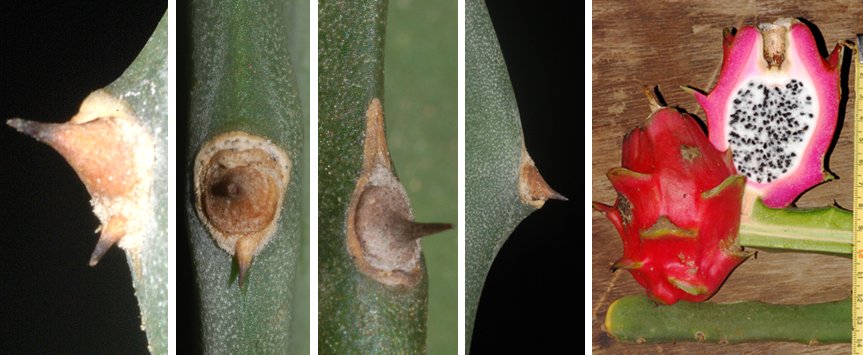 |
QUICK SEARCH
MO PROJECTS:
Africa
Asia/Pacific
Mesoamerica
North America
South America
General Taxonomy
Photo Essays
Training in Latin
America
MO RESEARCH:
Wm. L. Brown Center
Bryology
GIS
Graduate Studies
Research Experiences
for Undergraduates
Imaging Lab
Library
MBG Press
Publications
Climate Change
Catalog Fossil Plants
MO DATABASES:
W³MOST
Image Index
Rare Books
Angiosperm
Phylogeny
Res Botanica
All Databases
INFORMATION:
What's New?
People at MO
Visitor's Guide
Herbarium
Jobs & Fellowships
Symposium
Research Links
Site Map
Search
|
Draft Treatments | Guidelines | Checklist | Citing | Editors The Cutting EdgeVolume XXI, Number 3, July 2014News and Notes | Leaps and Bounds | Germane Literature | Season's Pick SEASON'S PICK: Hylocereus monacanthus (Lem.) Britton & Rose (Cactaceae) is the recipient of this quarter's honor.
We have featured Cactaceae in this spot on numerous occasions, certainly way out of proportion—in a purely statistical way—to their representation in the flora. However, most have spectacular flowers, and many of them do their thing this time of year, when not much else is flowering!
On a trip to the Golfo Dulce region at the beginning of this past season, we finally bagged good photos and specimens of what we had long presumed to be Hylocereus monacanthus, but could not be certain; previously collected material was insufficient to verify the characteristic bilobed stigma lobes that have been associated with the sp. As these photos demonstrate, said bilobed stigma lobes are now confirmed for the native Costa Rican plants, which are also characterized by having few (one or two, rarely as many as four) areolar spines, and only slightly or non-overlapping ovary bracteoles. At least at this one locality (toward the south end of the Valle de General), the pulp of the mature fruits is white. All of this is in contrast to H. costaricensis (F. A. C. Weber) Britton & Rose, which commonly has 3–5, slightly longer spines, simple stigma lobes, strongly overlapping bracteoles and fruits with magenta pulp. These photos are vouchered by Hammel & Pérez 26719. Manual co-PI Barry Hammel has had live material of this sp. growing at his house for many years, but since it was from a cultivated plant of unknown origin (other than a wall in downtown San José) he had paid it little attention, other than to marvel at its flowers. This year his cultivated plants produced abundant fruits for the first time, and these too have white pulp at maturity. Interestingly, most of these fruits split open partially, revealing the white pulp in strong contrast with the red pericarp. This spontaneous splitting is something as yet unobserved in fruits of H. costaricensis. More images of H. monacanthus can be seen at Hammel's Flickr site: https://www.flickr.com/photos/68114448@N06/sets/72157644403873346/ For comparison with H. costaricensis see also: |
© 1995-2025 Missouri Botanical Garden, All Rights Reserved
4344 Shaw Blvd.
St. Louis, MO 63110
(314) 577-5100
Technical Support

